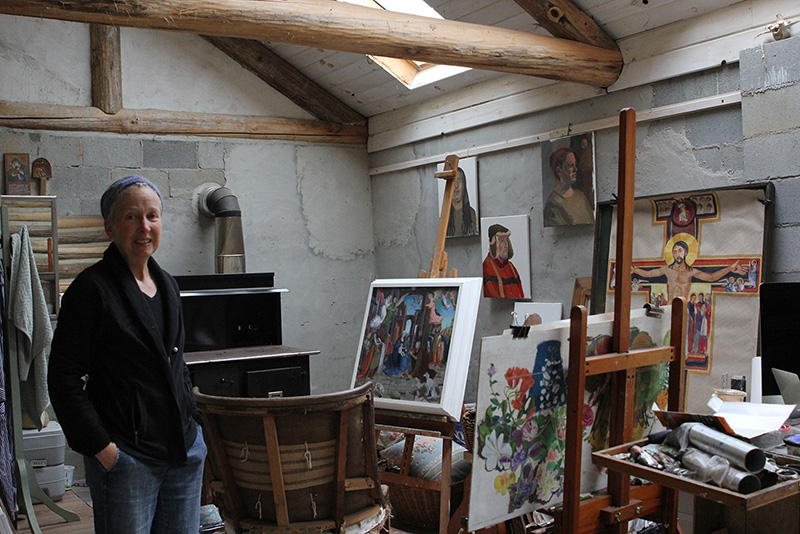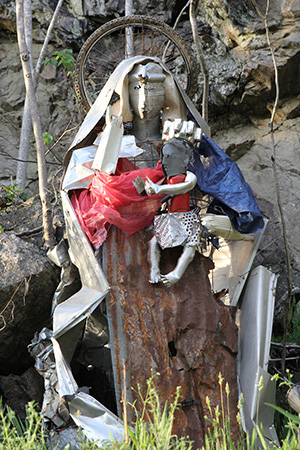 A 10-foot statue of the Virgin Mary fashioned from some of the 10 million cubic yards of Helene debris (below) has given Marshall residents hope. It was created by Catholic artist Beth Cefula, shown in her studio.MARSHALL — Looking down the mountainside from the cottage of St. Andrew the Apostle parishioner Beth Cefula, the town of Marshall looks similar to “Mister Rogers’ Neighborhood.” The mid-century brick buildings, the church steeples, the red caboose, the courthouse and the bank have all the makings of a quaint Southern mountain town.
A 10-foot statue of the Virgin Mary fashioned from some of the 10 million cubic yards of Helene debris (below) has given Marshall residents hope. It was created by Catholic artist Beth Cefula, shown in her studio.MARSHALL — Looking down the mountainside from the cottage of St. Andrew the Apostle parishioner Beth Cefula, the town of Marshall looks similar to “Mister Rogers’ Neighborhood.” The mid-century brick buildings, the church steeples, the red caboose, the courthouse and the bank have all the makings of a quaint Southern mountain town.
Once on level ground halfway over the bridge that crosses the French Broad River, the illusion shatters. The concrete dam is cracked, the churches are boarded up, almost every building has broken windows, and the caboose is turned sideways.
Red spray paint is streaked on most doors, indicating a date and a count. The date, Sept. 27, 2024, forever stained Marshall’s streets – Tropical Storm Helene. An outsider looking in knows something happened here, something bad and hard. It’s evident in the buildings with their missing storefronts and closed signs.
Yet there is a striking sign of hope amid the ruins in this town known for its artists. A 10-foot statue of the Blessed Virgin Mary fashioned from storm debris mysteriously appeared. The statue has been dubbed “Our Lady of Marshall,” “Mary of the Storm” and “Blessed Mother of Debris.” With a veil made of a bent gutter and a bicycle tire for a halo, she holds the infant who wears a Ford center cap as a crown and grips His mother’s gown, made from a thick red trash bag. It stands watch over a town that has seen too much destruction.
“It was tragic,” Cefula recalled. “An artist, a weaver who just moved in, lost all her looms; the building was completely washed away. Lois Simbach, another popular artist, her building was also completely lost. Some people are getting a lot of help and support, but there are still people in other buildings where nothing is being done.”
Signs of hope
But the people of Marshall are too creative, too involved and too in love with their small community to sit idle. The buzz and hum of bulldozers and power tools fill the half-mile stretch where people are busy landscaping, cleaning, painting and rebuilding.
There are signs of hope. Marshall’s Mad Co. Brew House reopened. Zuma Coffee is still serving a fresh brew. But for other businesses, six months just haven’t been long enough.
The town is known for its art, and hope shines through the mural of the mountains, the painted guitar butterfly, the multicolored hummingbird perched in the parking lot. Just outside of town – where the Blue Ridge Mountains and the raging current of the French Broad are separated by a concrete road – is where Our Lady of Marshall appeared.
The townspeople have been uplifted by its presence. The Marshall Arts Council is now sponsoring a contest for the best piece of art made from Helene debris.
“Beth thought they would take it down. Instead, people in town are passing by it and oohing and aahing,” Irma Fiordalisi, St. Andrew parishioner, said. “They are saying it is beautiful and wonderful. And everyone is like, who made it?”
The inspiration
 A small group knows the origin story of the Mysterious Mary. The three walk the streets on Friday afternoons with beads in their hands and chant something familiar that most everybody has heard but lost roots in this town way before the flood: the Hail Mary.
A small group knows the origin story of the Mysterious Mary. The three walk the streets on Friday afternoons with beads in their hands and chant something familiar that most everybody has heard but lost roots in this town way before the flood: the Hail Mary.
Cradle Catholic and artist Cefula, with her St. Andrew parishioner friends Fiordalisi and Stephen Simpson, want to see God brought back into the boarded up churches and would love a Catholic presence in the small community. Cefula is trying to buy one of the damaged buildings to create a small chapel. She wants somewhere close to pray, somewhere to gather, somewhere in Marshall for Catholics to have fellowship.
“I like history, I like taking old buildings and bringing them back to life, and now, we have a lot of them here,” Cefula said.
Cefula owns 10 acres up the mountain, filled with her own sacred art – stained-glass windows, paintings of the saints, wooden etchings, Coke cans cut into angel formations.
Her hand-drawn Stations of the Cross are laminated and going up around her ridge line – so, of course, she was behind Our Lady of Marshall.
After walking to the edge of town on the last sorrowful mystery, she and her friends stopped, looked at the rocky cliff and nodded.
“It was a really cold Friday and there were all these icicles, and when we were done with the sorrowful mysteries of Mary, we ended up there. We thought this is a grotto for Mary,” said Cefula. “I told Irma we should have a statue there; we should have Mary. I had an idea and, of course, the artist in me went with it.”
Treasures in the river
Cefula found treasures in and around the river to bring her masterpiece to life.
“I took what I could. Jesus is actually made from a fire extinguisher. It is all put together with trash I found from Helene,” said Cefula. “It just seemed natural and right.”
She spent an hour, here and there, in between feeding her sheep and baking sourdough bread. She started with the legs of Jesus and Mary’s face, which she cut out of tin roofing. After a few weeks, the Blessed Lady was fully assembled.
“Everyone is in a rush to clean up, but let’s not erase it. This is also something we should remember,” Cefula said.
It took about 10 minutes for her and Simpson to install Our Lady, all the while in fear someone would stop them, but people didn’t notice or care, and perhaps they appreciated it.
“I just tied it to two trees and left it there. It looks great,” said Cefula. “No one has really said anything to me because it was kind of done in secret. It’s kind of like it just appeared. No one needs to know I did it.”
Now, Our Lady of Marshall remains on the edge of town in darkness and in light, praying for the town to heal, rebuild and remember God.
— Lisa M. Geraci


